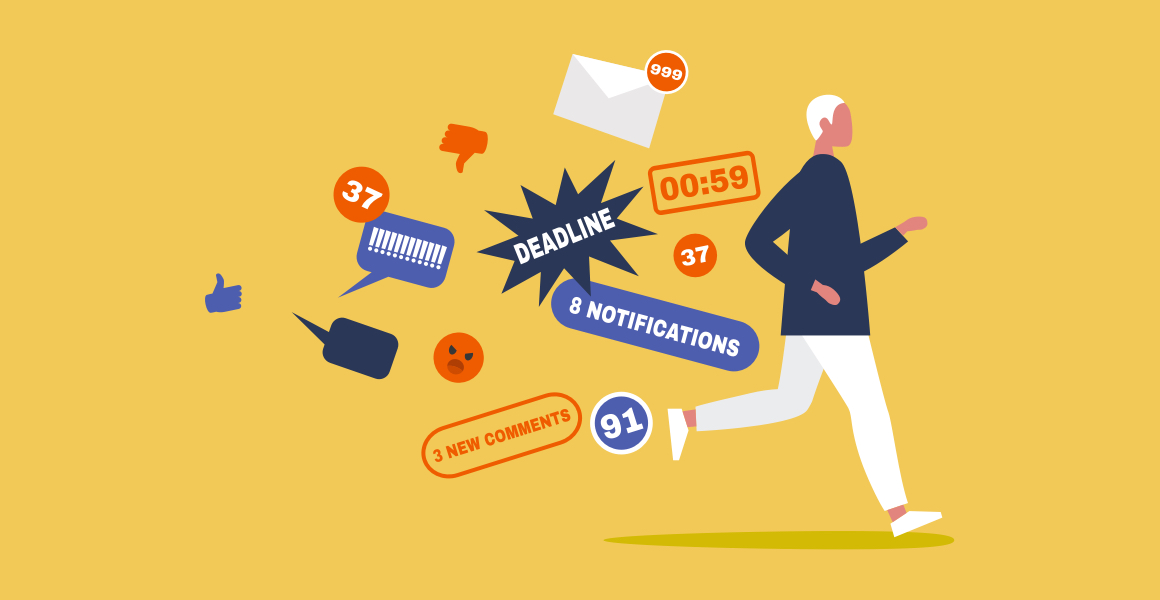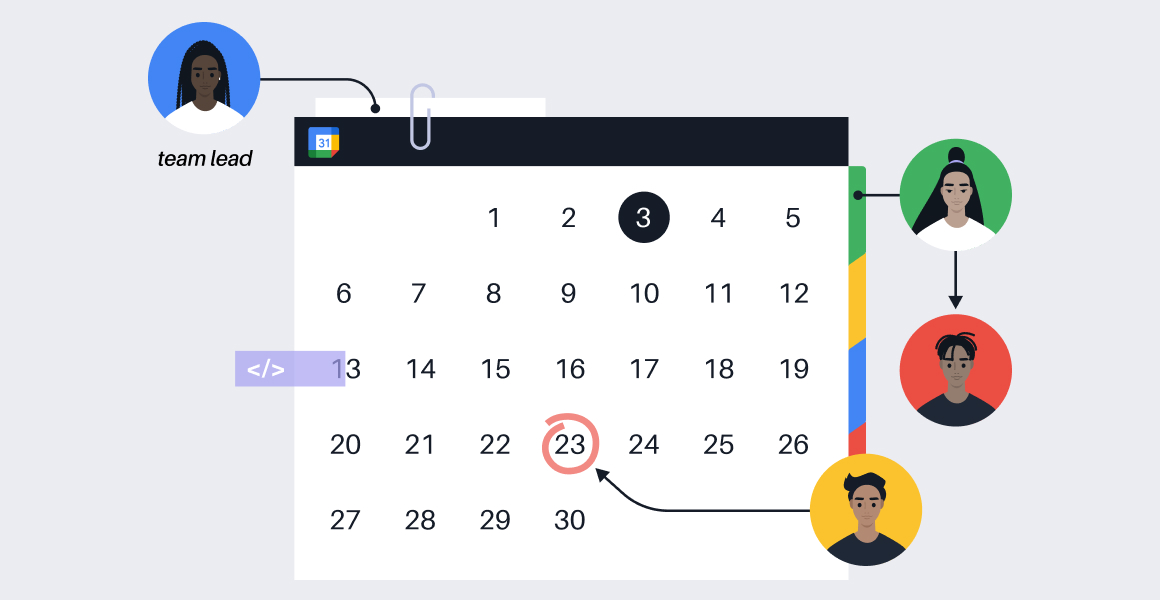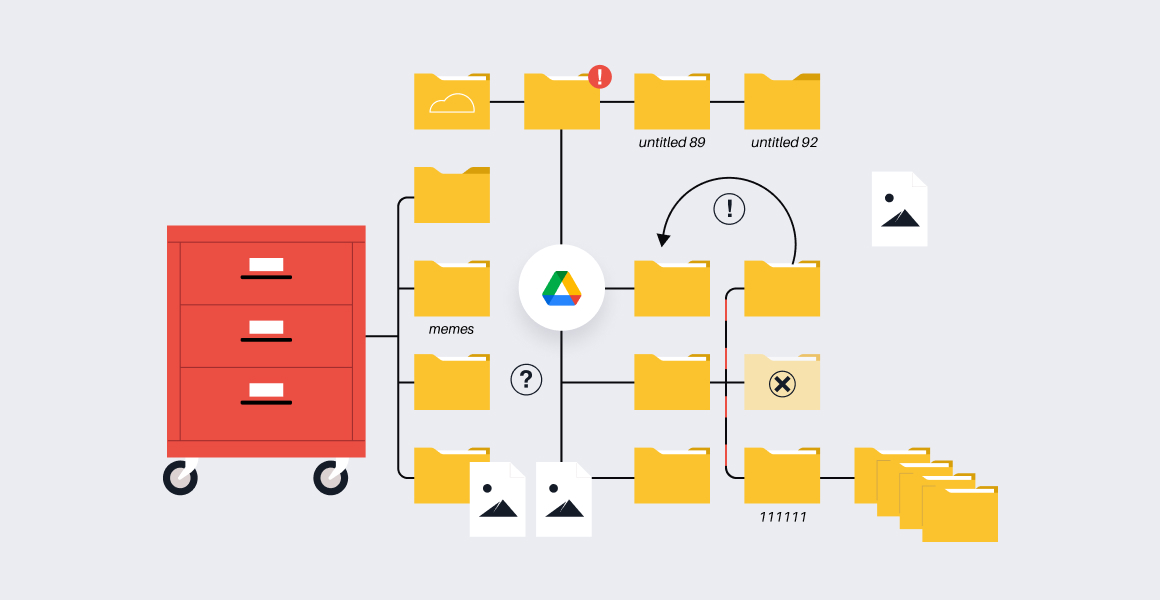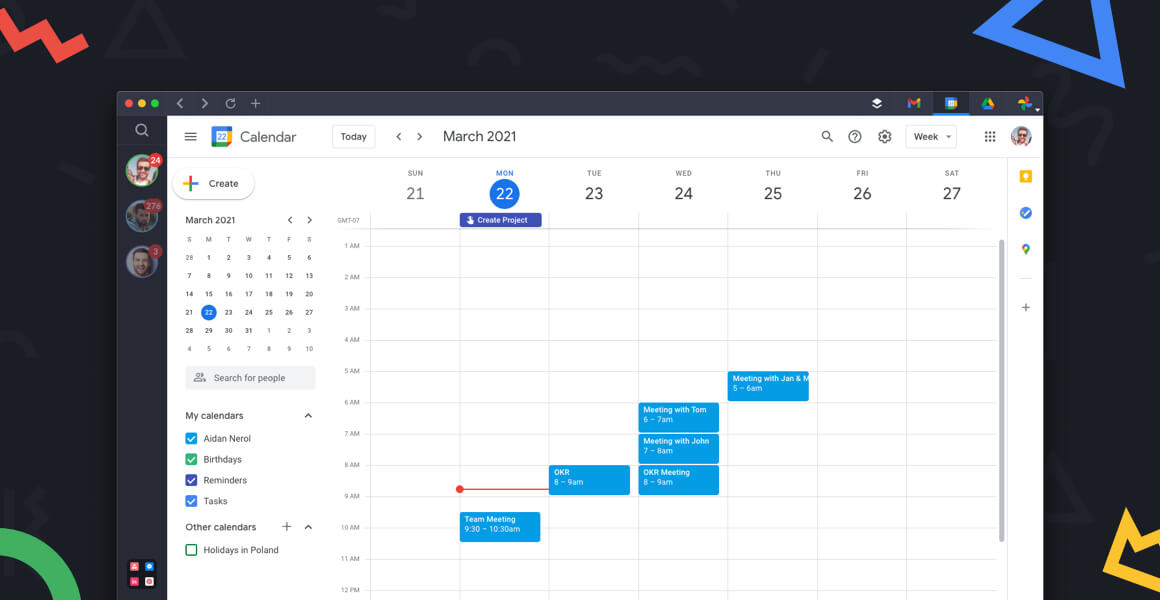Google Calendar is one of the most powerful tools available for management and scheduling. Just like the rest of the Google suite of products, it’s intuitive and is designed to play well with other platforms. Many people use Google Calendar to manage their time in the most effective way possible. If you’re already using Google Calendar, chances are you understand how impactful it can be in managing your day-to-day activities and schedule. If not, we suggest creating an account and giving it a try!
Proper organization of your calendar is essential for making the most of your time. The innovative features offered by Google help those with even the most complex schedules to streamline their efforts. The ability to create multiple calendars, share schedules with others, and get reminders are a big help. Google Calendar also integrates with a wide range of other tools, to streamline your entire digital life.
To make things even better, we’ve compiled a list of hacks that can be used to level up Google Calendar’s performance. These tricks will help you to be even more productive and effective, whether you’re using the tool for personal or professional use.
Use Shift to manage multiple Google Calendar accounts
Many people have multiple Google Calendar accounts. Some people have separate accounts for personal and work purposes. It’s great that Google Calendar is a tool that makes this easy, but users need to deal with logging in and out or sharing calendars. Shift is a productivity tool that makes it simple to reduce the log in and out process and easily switch back and forth between Google accounts. Toggle between Gmail, Outlook, or other email platforms with a few simple clicks. Connect all of your Gmail, Outlook, and Office 365 accounts and manage everything from one centralized workstation.
Related Article: How to Manage Multiple Google Calendars
Use voice technology
When you’re on the go, it can be difficult to stop what you’re doing and type something on your phone or device. That’s why using your voice to add events can be particularly helpful. Instead of opening the app and typing details into your calendar, you can simply say something like “Google, create a calendar event: dinner with Hank Thomas at 6pm at Mastro's Steakhouse”. That information will then be added to your calendar as you described. In some cases, you’ll be asked follow-up questions which can help to make sure all the relevant information is present.
Drag and drop events
When events need to be rescheduled, Google Calendar makes it easy to simply move the entry. For example, when a meeting has to be moved to another date but other details are the same, you can simply drag and drop the item to the new day. This saves you from having to create new events from scratch. Simply click on the event and relocate it to the new time using your cursor.
Color code different calendars
It’s not easy to manage several facets of life in one space. If you’re like most people, you have a variety of projects, commitments, and personal and professional things to schedule. On just one calendar, that can become cluttered and overwhelming. Google lets you color-code different parts of your life so you can better organize everything in your calendar. For example, you might use red for work-related items, blue for social engagements, and green for kids’ schedules. Color-coding makes it easy to visually comprehend your schedule at a glance. This gives users a better understanding of what your day, week, or month looks like. A bonus is that you can have a better understanding of how you actually spend time and which areas intersect with each other.
Change your calendar view
Google Calendar makes it easy to customize the view you use. You can choose from options like day, week, month, schedule, or four days. Most people find that customizing their calendar view helps with avoiding distractions. For instance, selecting a day view means you can focus on what you have going on that specific day without thinking about what else you have going on that week or month. At the same time, keeping a calendar view open to your week will let you see where you have lighter days, making it easier to schedule future events. The point is you can choose the view that works for you and the way that you like to do things.
Use appointment slots
This feature is only available with a school or work account. Appointment slots are blocks of time that other people can block on your calendar. For instance, professors can invite their students to reserve time during office hours each week. These slots are very useful when you don’t know who exactly needs to meet with you, but you want to be available. Simply offer a block of time on your calendar that attendees can book slots within. To use this functionality, follow these steps:
-
- Open your calendar and choose either Day or Week view.
- Click anywhere in the calendar and when the event box appears, choose Appointment Slots.
- Enter details like the title, and then select the calendar where you want the event to be displayed.
- Add more information that might be relevant, like the location, by clicking on “More options”.
Share your calendar with others
Sharing your calendar can be surprisingly beneficial. This is particularly true when you’re working with others. Maintaining a calendar that you share with others on your team ensures that everyone is aware of important dates and deadlines. A shareable view on your calendar also reduces confusion that can lead to arriving late or missing meetings. Many people also find shareable calendars helpful in their personal lives. For example, your family can view your travel itinerary while you’re on vacation. This is a popular feature among married couples, as they can quickly see what the other person has scheduled before making commitments. It’s perfect for seeing when people are available and when they are otherwise engaged. To share a Google Calendar, go into Settings and add the email addresses of those you want to share the calendar with. You can also pull a shareable link that you can copy and send via email.
Embed a calendar
You can also share your availability with others by embedding your calendar onto a website. This is really helpful when you want other people to see when you are open or attempt to schedule something with you. To set this up, find Settings, scroll down to “Integrate calendar”, and copy your calendar’s embed code. This places your calendar directly on your website. This is a huge time saver when it comes to scheduling things with others; it eliminates the back and forth of choosing a time and lets them go directly to the source and pick a time that works for everyone.
Sync your calendar
One of the best features about online calendars is that you can import and export them to virtually anywhere. If you use two different platforms - for example, Outlook for work and Google Calendar for personal - you can export your work calendar so that it syncs with your personal schedule. Then you can view your total schedule without having to bounce between apps. This is a really helpful tutorial about syncing Google Calendar to Outlook. You can even take things a step further and sync your calendar with voice assistants.
Add important reminders
How often do you want to add a calendar event to your schedule months in advance? Things like saving the date for a wedding or important annual meetings can be easy to forget if they are far off in the future. In these cases, setting auto reminders in your calendar will be really helpful. Start by clicking on “Settings” and scrolling to “Settings for my calendars” to change your event notifications. From here you can choose how much notice to give yourself before an event, for example a few minutes or 48 hours (or more). You can even set up an email notification as well. You can also use voice commands to say to your phone to set up a reminder for a certain date.
Use desktop notifications
Like any technology, Google Calendar isn’t perfect. Some users don’t like the notification features. It can be distracting to be in the middle of something and have a large pop-up interrupt your activity. This is particularly difficult if you have a full day with several appointments - you’ll have several reminder pop-ups appearing throughout your day, which can be annoying when you are trying to complete tasks. You can avoid this by going into your settings and scrolling to “Event Settings”, then changing the view to “Desktop Notifications”. That way you’ll receive a more gentle, less intrusive reminder. You’ll see notifications in the top right corner of your screen instead of a larger pop-up in the middle of your screen.
- Pro-tip: Streamline notifications with Shift. If it feels like notifications are taking over your life (and your screens), you can minimize their effects by implementing Shift. Shift offers notification management that can apply across all the apps you use every day, from Outlook to Facebook to Slack and beyond. With a couple of clicks, you can mute all notifications temporarily or control the sounds that play when a notification comes through. Shift brings together all of the notifications from any of your apps and email accounts and displays them in one place.
Related Article: How to Avoid Notification Overload

Set your OOO
Out-of-office options aren’t just for Outlook. This feature is really helpful and enables many users to balance their work and personal lives. Google Calendars allows you to choose specific “working” hours. This means if someone tries to schedule a meeting outside of these hours, it will automatically be declined. This is always helpful, but particularly when you are off work or on vacation and can’t take the time to respond to requests immediately. You can also set an OOO message when you’re simply not available. It’s always convenient for people to know when you’re unavailable and when you’ll be back. You can also include what steps people should take in the meantime. For instance, you may want to give clients specific instructions on what they should do in urgent situations on your day off.
Hide calendars and events
Depending on how much you’ve got going on, even a color-coded calendar might feel cumbersome. To limit distractions, you may want to hide certain calendars or events so that they aren’t in your periphery. For example, if you are trying to concentrate on your work schedule, you may not want to see things like birthday reminders. In your settings menu, you can choose whether or not to view declined events or weekend activities.
Get a daily agenda via email
A daily agenda email will make you feel like you have your very own personal assistant! By going into Settings and selecting a calendar view on the left-hand side, you can have one emailed to you. Once you pick what you want to view in an email, it will be sent to you each morning at five am. This is a really handy way to see what the day has in store for you.
Enable tasks
Organizing projects or bigger efforts into smaller chunks is a great way to make progress. Enabling tasks in your Google Calendar is a smart way to manage the task elements of larger initiatives. On the right side of your calendar, you’ll see a small “Tasks” icon. Click on it to add a title, event details, date and time, and subtasks. Once you have enabled the task feature, you can sort action. Choose the order of tasks or dates to prioritize important work. Once you have completed a task, you’ll get a message from Google letting you know that it’s done.
See events from your Gmail
There are many events which end up in your Gmail after you’ve made arrangements. Everything from the flight you booked for vacation to the restaurant reservations you made for your anniversary get sent to your Gmail account (if that’s the one you used to set things up). Then, these events can be automatically added to your calendar as well. You’ll get a notification before the particular event as well. Even though this is something that just happens without you setting anything up, it’s still a good reminder that you should use Gmail when making plans. That way you will have events created and get reminders without having to do anything.
Related Article: Gmail Hacks Guaranteed to Make Email Management Easier
Use keyboard shortcuts
Keyboard shortcuts are helpful for managing all kinds of things on your computer, and Google Calendar is no exception. Taken together, these shortcuts can add up to valuable time saved. Here are a few of the shortcuts worth knowing:
-
- Create an event - C
- Add event details - E
- Delete an event - Delete or Backspace
- Undo last action (if possible) - Ctrl+Z or Z
- Jump to the previous time period - K or P
- Jump to the next time period - J or N
- Refresh page - R
- Today’s view - T
- Day view - 1 or D
- Week view - 2 or W
- Month view - 3 or M
- Custom view - 4 or X
- Agenda view - 5 or A
- To add a calendar - Shift + = or +
- Quick add - Q
- Print - Ctrl + P or Command + P
- Go to settings - S
- Find the keyboard shortcuts menu - ctrl +? / command + ? or ?
Add specific locations to meetings
Planning a meeting involves a lot of logistics. You need to find a date and time that works for everyone, and worry about a meeting place. When you create an event in Google Calendar, you can add a specific meeting location address. Then, your calendar will integrate with Google Maps so that people can see the precise location and even get directions automatically. This is a great time-saver for attendees as they don’t need to look up directions, or even worse, call you asking “which Starbucks?”. This feature is a great example of the power of using the entire Google suite together to make the most of your time.
Use the “find a time” feature
This functionality is available if you have a Google account for work, school, or a group - and it can make finding acceptable meeting times a lot easier. To use it, open an existing event in your calendar and then click on the “Find a time” tab located at the bottom right corner. There you can find calendars that have been shared with you and navigate between them to find an appropriate time slot for all attendees. Once you’ve picked a time, click the area within the calendar grid, and it will be added. If you hope to do this, but someone hasn’t shared their calendar with you, then request access. Chances are they will permit you access to their calendar and you can go from there.
Add attachments to events
Sometimes it’s really handy to have a document included right in the event, so that people can quickly grab it and reference it. This can be documents that are needed to complete a task, or just a meeting agenda. It can be really helpful for attendees and save them from asking you for things in order to be prepared for the meeting time. Thankfully, it’s pretty easy to add these things to an event. Simply click on the paper clip within the description of the event and add the appropriate file that needs to be shared.
Related Article: Google Drive Hacks to Organize Your Digital Life
Pick the starting day of your week
Are you a person who starts your week on Sunday? Or does your week start at the beginning of a typical work-week (Monday)? In Settings, Google Calendar gives you the option to change the beginning of your week view. Scroll to View Options and then choose the day of the week that you want to kick off your week.
Use Google Calendar offline
It can be hard to believe it, but there might be times you are completely disconnected digitally. The good news is you can still see your calendar even during those times. However, this is only possible in the app. If you select “Offline mode” you can view your schedules, make edits, and create, edit, or respond to events and then everything will be synced when you’re back online.
Set up recurring events
Chances are you probably have a few events that occur each week, month, or quarter - or even every day. When you create the very first event, you can select how often you want it to repeat. Then you don’t have to continually create the same type of event.
Restore deleted events
Have you ever accidentally deleted an event that you didn’t mean to? It’s pretty easy to get it back by going to the Settings gear and then into the Trash folder, and clicking restore. This will put the item back into your calendar. However, it’s worth noting that Trash items are only available for 30 days, and you can only restore items that you actually had access to in the first place.
Streamline use with other productivity tools
You can integrate Google Calendar with other platforms that you use frequently to make your life easier. For example, Slack for communication and Zoom for video conferencing. If you are a Shift user, you can manage your different Google accounts and calendars in one view without logging in and out. Shift also condenses notifications and makes them much more manageable. You can explore all the different apps and extensions that Shift works with here.
Related Article: How to Get a Google Calendar App for Desktop
For more tips and tricks on maximizing productivity using today’s best tools, make sure to follow our blog.



















 Share on Facebook
Share on Facebook Share on Twitter
Share on Twitter







